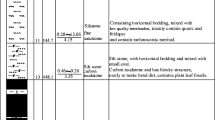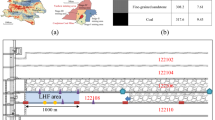Abstract
Hanging roofs can occur on a very large scale (generally can reach 15,000 m2) during the initial mining stages in longwall coal mining operations and are often a result of hard roof at the active mining face. Besides, when it suddenly fractures and caves, some risks and disasters would occur such as shock loading, wind blasts, and sudden gas extrusion from gob to working face. To control the size and competency of the hanging roof, Φ32-mm fracturing drills can create holes in the roof near the front and back coal walls, and Φ32-mm linear fracturing drills can be used to create holes in the roof at the face ends. The length of these drill holes is 3 to 5 times the height of the mining face and is based upon the principle that the gob should be fully filled with a caved roof to support vertical stresses, as well as the assumption that the broken-expansion coefficient of the rock is given as an empirical value. Considering the fracture propagation range and the support form of the cut, the drill-hole spacing is set to be between 1 and 2 times the single-hole crack propagation range. Hydraulic fracturing can generate main fractures and wing-shaped branching cracks inside the roof rock and can transform and weaken the roof structure, forming weak fracture plane favorable to roof caving. These fractures cause the roof to cave in a timely and adequate manner under in situ ground pressures. Successful field test in the no. 2 mine of Cuncaota, Shendong group indicated that the propagation range of hydraulic fractures is approximately 4–8 m. When the active face advanced 22.5 m, the roof beyond the hydraulic supports caves entirely, and gradually, the gob is fully filled with the caved roof and is absent of large voids. Thus, hazards such as shock loading, wind blasts, and sudden gas extrusion can be reduced or eliminated.












Similar content being viewed by others
References
Altounyan P, Taljaard D (2001) Developments in controlling the roof in South African coal mines—a smarter approach. J South Afr Inst Min Metall 101:33–40
Banerjee G, Ray AK, Singh GSP, Yadava KP (2003) Hard roof management—a key for high productivity in longwall coal mines. J Min Metal Fuel 51:238–244
Cheng QY, Huang BX, Li ZH (2012) The solid-liquid coupling structure of coal and permeability evolution law. J Min Saf Eng 29:400–406 (Chinese)
Chernov OI, Barsukov II, Posokhov GE (1997) Oriented hydraulic fracturing of a mass of rocks enclosing the “international” diamond pipe. J Min Sci 33:582–586
Dou LM, He XQ (2001) Rock-burst prevention theory and technology. China University of Mining and Technology press, Xuzhou (Chinese)
Gao MF (2006) Numerical simulation of hard roof processing step. J Liaoning Technol Univ 25:649–651 (Chinese)
Huang BX (2010) Research on theory and application of hydraulic fracture weakening for coal-rock mass. J. Chin. Coal Soc. 35:1765–1766 (Chinese)
Huang BX, Deng GZ, Liu CY (2007) The hydraulic fracturing weakening technology of coal-rock mass and its progress. Chin. Eng. Sci 9:83–88 (Chinese)
Huang BX, Cheng QY, Liu CY (2011a) The hydraulic fracturing theory of coal-rock mass and technology framework. J. Min. Saf. Eng. 28:167–173 (Chinese)
Huang BX, Liu CY, Fu JH, Guan H (2011b) Hydraulic fracturing after water pressure control blasting for increased fracturing. Int J Rock Mech Min Sci 48:976–983
Huang BX, Yu B, Feng F, Li Z, Wang YZ, Liu JR (2013) Field investigation into directional hydraulic fracturing for hard roof in Tashan Coal Mine. J Coal Sci Eng 19:153–159 (Chinese)
Huang BX, Wang YZ, Cao SG (2015) Cavability control by hydraulic fracturing for top coal caving in hard thick coal seams. Int J Rock Mech Min Sci 74:45–57
Huang BX, Zhao XL, Chen SL, Liu JW (2017) Theory and technology of hydraulic fracturing for controlling hard roof of underground mining. J Rock Mech Eng 36:1–17 (Chinese)
Jin ZM, Xu LS (1994) Control hard roof of mining. China Coal Industry Publishing House, Beijing (Chinese)
Lv MJ (2010) Shendong mining area longwall stope pressure law and shield selection. Coal Sci Technol 38:48–53 (Chinese)
Mu ZL, Dou LM, Zhang GW (2006) Hard roof type rock-burst disaster prevention research. J Chin Univ Min Technol 35:737–741 (Chinese)
Niu XZ (1988) Hard roof control of mining. J Rock Mech Eng 7:137–146 (Chinese)
Qian MG, Shi PW (2003) Ground pressure and strata control. China University of Mining and Technology Press, Xuzhou (Chinese)
Song XM, Lian QW, Xin PW (2009) Air impassive disaster research of large area caving in gob. Coal Sci. Technol 37:1–4 (Chinese)
Sun SS, Ning Y, Ge J (1999) The hard roof directional hydraulic fracturing technology in coal mines of Poland. Coal Sci. Technol 27:51–52 (Chinese)
Xi JB (2006) Hurricane disaster theory research of large area roof caving. M.Sc. Thesis, Taiyuan University of Technology, Taiyuan (Chinese)
Xiong RQ (1995) The breakage mechanism of the large area roof weighting. J. Chin. Coal Soc. 20:38–42 (Chinese)
Zhai GW (2008) The popularization and application of heavy face in ShenDong. J Chin Coal Soc 33:175–179 (Chinese)
Zhou HW, Shi PW (1991) Forecast coal and gas outburst through monitor roof movement. Grou Pres Strat Cont 3:21–28 (Chinese)
Zhu DR, Qian MG, Xu LS (1991) Weighting control of hard roof. J Chin Coal Soc 16:11–20 (Chinese)
Funding
This work was supported by the National Key Research and Development Program of China (No. 2016YFC0802900), the National Science Fund for Excellent Young Scholars (No. 51522406), and the Fundamental Research Funds for the Central Universities (China University of Mining and Technology) (No. 2015XKZD04).
Author information
Authors and Affiliations
Corresponding author
Rights and permissions
About this article
Cite this article
Huang, B., Cheng, Q., Zhao, X. et al. Using hydraulic fracturing to control caving of the hanging roof during the initial mining stages in a longwall coal mine: a case study. Arab J Geosci 11, 603 (2018). https://doi.org/10.1007/s12517-018-3969-5
Received:
Accepted:
Published:
DOI: https://doi.org/10.1007/s12517-018-3969-5




